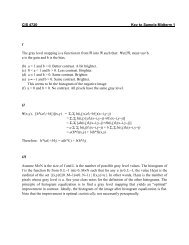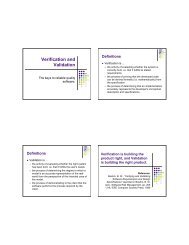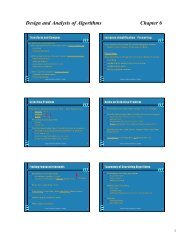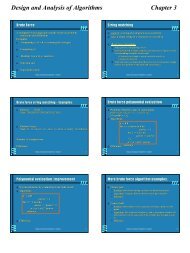Design and Analysis of Algorithms Chapter 4
Design and Analysis of Algorithms Chapter 4
Design and Analysis of Algorithms Chapter 4
Create successful ePaper yourself
Turn your PDF publications into a flip-book with our unique Google optimized e-Paper software.
<strong>Design</strong> <strong>and</strong> <strong>Analysis</strong> <strong>of</strong> <strong>Algorithms</strong> <strong>Chapter</strong> 4<br />
Divide <strong>and</strong> Conquer<br />
Divide-<strong>and</strong><br />
<strong>and</strong>-conquer technique<br />
The most well known algorithm design strategy:<br />
1. Divide instance <strong>of</strong> problem into two or more smaller<br />
instances<br />
2. Solve smaller instances recursively<br />
subproblem 1<br />
<strong>of</strong> size n/2<br />
a problem <strong>of</strong> size n<br />
subproblem 2<br />
<strong>of</strong> size n/2<br />
3. Obtain solution to original (larger) instance by combining<br />
these solutions<br />
a solution to<br />
subproblem 1<br />
a solution to<br />
subproblem 2<br />
a solution to<br />
the original problem<br />
<strong>Design</strong> <strong>and</strong> <strong>Analysis</strong> <strong>of</strong> <strong>Algorithms</strong> - <strong>Chapter</strong> 4 1<br />
<strong>Design</strong> <strong>and</strong> <strong>Analysis</strong> <strong>of</strong> <strong>Algorithms</strong> - <strong>Chapter</strong> 4 2<br />
Divide <strong>and</strong> Conquer Examples<br />
General Divide <strong>and</strong> Conquer recurrence:<br />
<br />
Sorting: mergesort <strong>and</strong> quicksort<br />
T(n) ) = aT(n/b<br />
n/b) ) + f (n) where f (n) ∈ Θ(n k )<br />
<br />
<br />
Tree traversals<br />
Binary search<br />
1. a < b k T(n) ∈ Θ(n k )<br />
2. a = b k T(n) ∈ Θ(n k lg n )<br />
3. a > b k T(n) ∈ Θ(n )<br />
<br />
<br />
Matrix multiplication-Strassen’s<br />
algorithm<br />
Convex hull-QuickHull<br />
algorithm<br />
Note: the same results hold with O instead <strong>of</strong> Θ.<br />
<strong>Design</strong> <strong>and</strong> <strong>Analysis</strong> <strong>of</strong> <strong>Algorithms</strong> - <strong>Chapter</strong> 4 3<br />
<strong>Design</strong> <strong>and</strong> <strong>Analysis</strong> <strong>of</strong> <strong>Algorithms</strong> - <strong>Chapter</strong> 4 4<br />
Mergesort<br />
Algorithm:<br />
Split array A[1..n] ] in two <strong>and</strong> make copies <strong>of</strong> each half<br />
in arrays B[1.. n/2 ] <strong>and</strong> C[1.. n/2 ]<br />
Sort arrays B <strong>and</strong> C<br />
Merge sorted arrays B <strong>and</strong> C into array A as follows:<br />
• Repeat the following until no elements remain in one <strong>of</strong> the arrays:<br />
– compare the first elements in the remaining unprocessed portions <strong>of</strong><br />
the arrays<br />
– copy the smaller <strong>of</strong> the two into A, while incrementing the index<br />
indicating the unprocessed portion <strong>of</strong> that array<br />
• Once all elements in one <strong>of</strong> the arrays are processed, copy the<br />
remaining unprocessed elements from the other array into A.<br />
Mergesort Example<br />
7 2 1 6 4<br />
<strong>Design</strong> <strong>and</strong> <strong>Analysis</strong> <strong>of</strong> <strong>Algorithms</strong> - <strong>Chapter</strong> 4 5<br />
<strong>Design</strong> <strong>and</strong> <strong>Analysis</strong> <strong>of</strong> <strong>Algorithms</strong> - <strong>Chapter</strong> 4 6
<strong>Design</strong> <strong>and</strong> <strong>Analysis</strong> <strong>of</strong> <strong>Algorithms</strong> <strong>Chapter</strong> 4<br />
Efficiency <strong>of</strong> mergesort<br />
All cases have same efficiency: Θ( n log n)<br />
Number <strong>of</strong> comparisons is close to theoretical minimum for<br />
comparison-based sorting:<br />
• log n ! ≈<br />
n lg n - 1.44 n<br />
Space requirement: Θ( n ) (NOT(<br />
in-place)<br />
Can be implemented without recursion (bottom-up)<br />
Quicksort<br />
Select a pivot (partitioning element)<br />
Rearrange the list so that all the elements in the positions<br />
before the pivot are smaller than or equal to the pivot <strong>and</strong><br />
those after the pivot are larger than the pivot (See<br />
algorithm Partition in section 4.2)<br />
Exchange the pivot with the last element in the first (i.e., ≤<br />
sublist) – the pivot is now in its final position<br />
Sort the two sublists<br />
p<br />
A[i]≤p<br />
A[i]>p<br />
<strong>Design</strong> <strong>and</strong> <strong>Analysis</strong> <strong>of</strong> <strong>Algorithms</strong> - <strong>Chapter</strong> 4 7<br />
<strong>Design</strong> <strong>and</strong> <strong>Analysis</strong> <strong>of</strong> <strong>Algorithms</strong> - <strong>Chapter</strong> 4 8<br />
The partition algorithm<br />
Quicksort Example<br />
15 22 13 27 12 10 20 25<br />
<strong>Design</strong> <strong>and</strong> <strong>Analysis</strong> <strong>of</strong> <strong>Algorithms</strong> - <strong>Chapter</strong> 4 9<br />
<strong>Design</strong> <strong>and</strong> <strong>Analysis</strong> <strong>of</strong> <strong>Algorithms</strong> - <strong>Chapter</strong> 4 10<br />
Efficiency <strong>of</strong> quicksort<br />
Best case: : split in the middle — Θ( n log n)<br />
Worst case: : sorted array! — Θ( n 2 )<br />
Average case: : r<strong>and</strong>om arrays — Θ( n log n)<br />
Improvements:<br />
• better pivot selection: median <strong>of</strong> three partitioning avoids worst<br />
case in sorted files<br />
• switch to insertion sort on small subfiles<br />
• elimination <strong>of</strong> recursion<br />
these combine to 20-25% 25% improvement<br />
Considered the method <strong>of</strong> choice for internal sorting for<br />
large files (n(<br />
≥ 10000)<br />
<strong>Design</strong> <strong>and</strong> <strong>Analysis</strong> <strong>of</strong> <strong>Algorithms</strong> - <strong>Chapter</strong> 4 11<br />
QuickHull Algorithm<br />
Inspired by Quicksort compute Convex Hull:<br />
Assume points are sorted by x-coordinate values<br />
Identify extreme points P 1 <strong>and</strong> P 2 (part <strong>of</strong> hull)<br />
Compute upper hull:<br />
• find point P max that is farthest away from line P 1 P 2<br />
• compute the hull <strong>of</strong> the points to the left <strong>of</strong> line P 1 P max<br />
• compute the hull <strong>of</strong> the points to the left <strong>of</strong> line P max P 2<br />
Compute lower hull in a similar manner<br />
P max<br />
P 1<br />
P 2<br />
<strong>Design</strong> <strong>and</strong> <strong>Analysis</strong> <strong>of</strong> <strong>Algorithms</strong> - <strong>Chapter</strong> 4 12
<strong>Design</strong> <strong>and</strong> <strong>Analysis</strong> <strong>of</strong> <strong>Algorithms</strong> <strong>Chapter</strong> 4<br />
Efficiency <strong>of</strong> QuickHull algorithm<br />
Finding point farthest away from line P 1 P 2 can be done in<br />
linear time<br />
This gives same efficiency as quicksort:<br />
• Worst case: Θ( n 2 )<br />
• Average case: Θ( n log n)<br />
If points are not initially sorted by x-coordinate x<br />
value, this<br />
can be accomplished in Θ( n log n) — no increase in<br />
asymptotic efficiency class<br />
Other algorithms for convex hull:<br />
• Graham’s scan<br />
• DCHull<br />
also in Θ( n log n)<br />
Strassen’s matrix multiplication<br />
Strassen observed [1969] that the product <strong>of</strong> two matrices<br />
can be computed as follows:<br />
C 00 C 01 A 00 A 01 B 00 B 01<br />
= *<br />
C 10 C 11 A 10 A 11 B 10 B 11<br />
=<br />
M 1<br />
+ M 4 - M 5 + M 7 M 3 + M 5<br />
M 2 + M 4 M 1 + M 3 - M 2 + M 6<br />
<strong>Design</strong> <strong>and</strong> <strong>Analysis</strong> <strong>of</strong> <strong>Algorithms</strong> - <strong>Chapter</strong> 4 13<br />
<strong>Design</strong> <strong>and</strong> <strong>Analysis</strong> <strong>of</strong> <strong>Algorithms</strong> - <strong>Chapter</strong> 4 14<br />
Submatrices:<br />
M 1 = (A 00 + A 11 ) * (B 00 + B 11 )<br />
M 2 = (A 10 + A 11 ) * B 00<br />
M 3 = A 00 * (B 01 - B 11 )<br />
M 4 = A 11 * (B 10 - B 00 )<br />
M 5 = (A 00 + A 01 ) * B 11<br />
M 6 = (A 10 - A 00 ) * (B 00 + B 01 )<br />
M 7 = (A 01 - A 11 ) * (B 10 + B 11 )<br />
<strong>Design</strong> <strong>and</strong> <strong>Analysis</strong> <strong>of</strong> <strong>Algorithms</strong> - <strong>Chapter</strong> 4 15<br />
Efficiency <strong>of</strong> Strassen’s algorithm<br />
<br />
<br />
<br />
If n is not a power <strong>of</strong> 2, matrices can be padded with zeros<br />
Number <strong>of</strong> multiplications:<br />
Number <strong>of</strong> additions:<br />
Other algorithms have improved this result, but are even<br />
more complex<br />
<strong>Design</strong> <strong>and</strong> <strong>Analysis</strong> <strong>of</strong> <strong>Algorithms</strong> - <strong>Chapter</strong> 4 16











